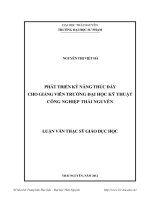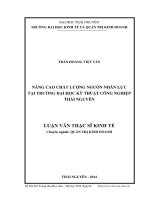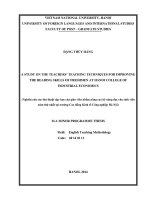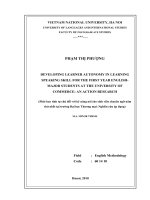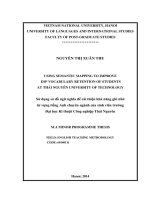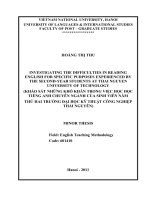CÁC YẾU TỐ ẢNH HƯỞNG ĐẾN KHẢ NĂNG ĐỌC HIỂU TIẾNG ANH CỦA SINH VIÊN CHƯƠNG TRÌNH TIÊN TIẾN NĂM THỨ NHẤT TẠI TRƯỜNG ĐẠI HỌC KỸ THUẬT CÔNG NGHIỆP THÁI NGUYÊN
Bạn đang xem bản rút gọn của tài liệu. Xem và tải ngay bản đầy đủ của tài liệu tại đây (467.59 KB, 6 trang )
<span class='text_page_counter'>(1)</span><div class='page_container' data-page=1>
<b>FACTORS AFFECTING FIRST-YEAR AP STUDENTS’ READING </b>
<b>COMPREHENSION AT THAINGUYEN UNIVERSITY OF TECHNOLOGY </b>
<b> </b>
<b>Hoang Thi Thu*, Phung Thi Thu Ha </b>
<i>University of Technology - TNU </i>
ABSTRACT
This paper presents a study on investigating the factors affecting first-year AP students’ reading
comprehension at Thai Nguyen University of Technology (TNUT). It is more reasonable to
compare and contrast the effects of some specific variables against each other to see whether
specifically vocabulary knowledge, syntax knowledge, reading strategies or background
knowledge was a more influential issue to academic reading comprehension. 30 students from
K53AP participated in the survey questionnaire. The findings reveal that syntax knowledge and
reading strategies are not strong predictors of reading comprehension for students. It is vocabulary
and background knowledge that have more influence on students’ reading comprehension. It is
advisable for the teachers to choose reading materials suitable for students’ level of competence,
design vocabulary exercises at pre-reading stage and learn how to activate their background
knowledge before any reading task.
<i><b>Key words: factors; reading comprehension; vocabulary; syntax; reading strategies; background </b></i>
<i><b>knowledge </b></i>
<i><b>Received: 04/01/2019; Revised: 22/01/2019; Approved: 28/3/2019 </b></i>
<b>CÁC YẾU TỐ ẢNH HƯỞNG ĐẾN KHẢ NĂNG ĐỌC HIỂU TIẾNG ANH </b>
<b>CỦA SINH VIÊN CHƯƠNG TRÌNH TIÊN TIẾN NĂM THỨ NHẤT </b>
<b>TẠI TRƯỜNG ĐẠI HỌC KỸ THUẬT CƠNG NGHIỆP THÁI NGUN </b>
<b>Hồng Thị Thu*<sub>, Phùng Thị Thu Hà </sub></b>
<i>Trường Đại học Kỹ thuật Cơng nghiệp - ĐH Thái Ngun </i>
TĨM TẮT
Bài báo trình bày nghiên cứu về khảo sát các yếu tố ảnh hưởng đến khả năng đọc hiểu tiếng Anh
của sinh viên chương trình tiên tiến năm thứ nhất tại trường Đại học Kỹ thuật Công nghiệp - ĐH
Thái Nguyên. Trong bài báo này, tác giả so sánh ảnh hưởng của các yếu tố cụ thể như từ vựng, cú
pháp, chiến lược đọc và kiến thức nền để từ đó xem yếu tố nào có ảnh hưởng nhiều hơn đến việc
đọc hiểu. Tham gia vào khảo sát này gồm có 30 sinh viên của K53 chương trình tiên tiến. Kết quả
khảo sát cho thấy cú pháp và chiến lược đọc không phải là yếu tố gây ảnh hưởng nhiều đến khả
năng đọc hiểu của sinh viên. Yếu tố ảnh hưởng nhiều đến quá trình này chính là từ vựng và kiến
thức nền của sinh viên. Vì vậy giáo viên cần lựa chọn giáo trình đọc sao cho phù hợp với trình độ
của sinh viên, thiết kế các bài tập về từ vựng cho phần trước khi đọc, và biết cách khai thác kiến
thức nền của sinh viên trước khi làm bất cứ bài tập đọc nào.
<i><b>Từ khóa: yếu tố, đọc hiểu, từ vựng, cú pháp, chiến lược đọc bài, kiến thức nền</b></i>
<i><b>Ngày nhận bài: 04/01/2019; Ngày hoàn thiện: 22/01/2019; Ngày duyệt đăng: 28/3/2019 </b></i>
</div>
<span class='text_page_counter'>(2)</span><div class='page_container' data-page=2>
INTRODUCTION
Reading is not only an important means to get
knowledge but also a means of further study.
According to Anderson, reading is one of the
most important skills to master. “With
strengthened reading skills, ESL/ EFL
(English second language/ English foreign
language) readers will make greater progress
and attain greater development in all academic
areas” [1]. In other words, EFL students who
become efficient readers can access and gain
more knowledge in many fields.
However, reading and comprehending texts in
the native language is different from in a
foreign language. Grabe suggested that
students begin reading in a second language
by using a different knowledge base
compared to when reading in their native
language. He stated that most of the mother
tongue readers already know many words and
a lot of basic grammar before they start to
read, whereas most of the second or foreign
language readers are new to the language and
do not have those abilities [2]. Goodman
defined reading as a “psycholinguistic
guessing game” [3] or “a process in which the
reader picks and chooses from the available
information only enough to select and predict
a language structure which is decodable” [4].
Moreover, comprehending words, sentences,
and entire texts needs not only linguistic
knowledge but also includes one’s knowledge
of the world [5]. Coady also supported the
need for interest and background knowledge
for enabling students to comprehend and
involve themselves in the text despite their
syntactic difficulties [6]. Consequently, a
problem can occur when ESL/EFL students
do not have sufficient knowledge of
vocabulary, grammar, background knowledge
and motivation, which affects their reading
comprehension.
Reading is significant for AP students who
learn English as a foreign language because
most educational and professional academic
texts are available in English. Therefore, AP
students are required to read written English
resources in order to obtain such knowledge
in their higher education. As a result, AP
students who are studying cannot avoid
reading. However, in spite of the efforts of the
students, the teachers often find their
students’ reading skill disappointing, which
does not meet the requirements of the
university. So far there has been no official
study into the factors which affect the
students’ reading comprehension. Hence, in
this paper, I would like to find out the factors
which affect the reading comprehension in
English of the students to find the answers to
the following questions:
What are the factors affecting reading
comprehension of AP first-year students at
TNUT and what is the relationship among the
factors?
THE STUDY
<i><b>The subjects </b></i>
The participants in the study were 30
first-year AP students majoring in electrical and
mechanical specialties, including 4 female
student and 26 male students. They have
learnt English at school for seven years and
<b>then at university for two terms. </b>
<i><b>The instruments </b></i>
The study was conducted with a combination
of the two main data collection instruments
including a questionnaire and interviews with
the teachers.
<i>Questionnaire </i>
The questionnaire was partly adapted from
Sajeerat's study. It consisted of three
questions, two of which were closed-ended
based on five-point Likert scale. The last
question was open-ended. Besides, there was
a Vietnamese version of the questionnaire to
avoid possible misunderstanding.
<i>Interviews </i>
</div>
<span class='text_page_counter'>(3)</span><div class='page_container' data-page=3>
gather information on the students' attitudes
towards reading practice activities, factors
affecting their reading comprehension.
<i>Data collection and analysis </i>
The questionnaire was administered with all
the 30 students and it was returned within one
day. The data was analyzed through the
descriptive statistical procedures of SPSS
Version 20.
RESULTS
<b>Results from questionnaire </b>
The findings collected from the questionnaire
are presented and discussed in two categories:
students’ attitude towards reading, factors
affecting students’ reading comprehension.
<i><b>Students’ attitude towards reading </b></i>
The results revealed that most of the students
highly appreciated the importance and
necessity of reading in English learning.
<i><b> Table 1. Students’ attitude towards reading </b></i>
Item N Min Max Mean S. D
importance 30 1 5 4.30 .794
necessity 30 2 5 <b>4.43 </b> <b>.679 </b>
like 30 1 5 3.10 .803
<i><b>Factors </b></i> <i><b>affecting </b></i> <i><b>students’ </b></i> <i><b>reading </b></i>
<i><b>comprehension </b></i>
<i>Vocabulary knowledge </i>
It can be seen from Table 2 that Item 2
(terminology) got the highest mean (M =
4.13, SD = .730). The lowest mean fell into
Item 4 (meaning of polysemantic words) (M
= 3.37, SD = 1.033).
<i><b>Table 2. Vocabulary knowledge </b></i>
<b>Item </b> <b>N </b> <b>Min Max Mean </b> <b>S.D </b>
1 newword 30 2 5 3.77 .803
2 term 30 2 5 <b>4.13 </b> <b>.730 </b>
3 phrase 30 1 5 3.63 .964
4 mean 30 1 5 3.37 1.033
<i>Syntax knowledge </i>
It is revealed from Table 3 that the highest mean
belongs to Item 2 (Organisation of the text) (M=
3.40, SD = .855). The lowest mean was Item 3
(substitution), which got 2.80 points.
<i><b>Table 3. Syntax knowledge </b></i>
<b>Item </b> <b>N </b> <b>Min Max Mean </b> <b>S.D </b>
1 structure 30 1 5 2.87 1.008
2 organisation 30 2 5 <b>3.40 </b> <b>.855 </b>
3 substitution 30 1 5 2.80 1.126
<i>Reading strategies </i>
From the table, we can see that item 2 (guess
the meaning of new words) got the highest
mean (M=3.67, SD=.959), while item 1
(guess the content of the text) got the lowest
mean (M=2.8, SD=.805).
<i><b>Table 4. Reading strategies </b></i>
<b>Item </b> <b>N </b> <b>Min Max Mean </b> <b>S.D </b>
1 guesscontent 30 1 4 2.80 .805
2 guessword 30 1 5 <b>3.67 </b> <b>.959 </b>
3 wordbyword 30 1 5 2.83 1.053
4 implication 30 1 5 3.43 1.04
<i>Background knowledge </i>
As can be seen from table 4, item 1 (different
background) got the higher mean than item 2
(limited background).
<i><b>Table 5. Background knowledge </b></i>
<b>Item </b> <b>N </b> <b>Min Max Mean </b> <b>S.D </b>
1 different 30 1 5 <b>3.70 </b> <b>1.149 </b>
2 limited 30 1 5 3.50 1.042
<i><b>Rank order of factors based on the average </b></i>
<i><b>mean </b></i>
Table 6 shows that item 1 (vocabulary) got
the highest mean (M=3.72) and item 2 got the
lowest mean (M=3.02).
<i><b>Table 6. Rank order of factors </b></i>
<b>Item </b> <b>N </b> <b>Min Max Mean </b>
1 vocab 30 1 5 <b>3.72 </b>
2 syntax 30 2 5 3.02
3 strategies 30 1 5 3.18
4 background 30 1 5 3.60
<i><b>Recommendations from students </b></i>
Some of the participants offered
recommendations to the teacher on reading
textbooks. They suggested that the reading
topics be familiar with their real life, the level
of difficulty be suitable to student’s
competence and there be a wordlist at the end
of each lesson.
</div>
<span class='text_page_counter'>(4)</span><div class='page_container' data-page=4>
Two out of three teachers interviewed
answered that students don’t like reading
because it is boring and theoretical. They also
listed the factors affecting students’ reading
comprehension such as: reading skills,
vocabulary, grammar, background
knowledge, reading habits. Their suggestions
were nearly the same as recommendations
from the students.
DISCUSSION AND SUGGESTED
IMPLICATIONS
<i>Students’attitude towards reading </i>
Satisfactorily, all of the students taking part in
the study were aware of the importance and
necessity of reading, expressing that it plays a
significant role in English learning. This is
easy to understand. After the first year, they
will learn all major subjects in English. They
have to deal with written materials very often
so reading is practised more than other skills.
However, they were in doubt whether they
like reading or not. So the problem is how to
raise their interest in learing reading.
<i>Factor of Vocabulary knowledge </i>
In the field of vocabulary, students agreed
with three out of four items which have
influence on their reading comprehension.
What hinders them most is the terminology
used in the text. They have to deal with texts
of different themes. Sometimes there are
terms which they even don’t find the
equivalent meaning in their native language.
Similarly, new words and phrases prove to
have equal effect on the students in their
learning reading. It is advisable for the
teacher to design vocabulary exercises for
students to do in pre-reading activities,
helping them understand the content of the
text better. At the end of the lesson, there
should also be a wordlist and their
explanations or meanings for them to
self-study at home.
<i>Factor of syntax knowledge </i>
In general, the students were in doubt whether
syntax knowledge affects their reading
comprehension with the mean score ranging
from 2.8 to 3.4. It seems that they can partly
cope with the problems of the structures,
organisation of ideas in the text, eclipsis and
substitution used in the text without
misunderstanding. This is easy to understand
because English teaching in most schools is
grammar-based, the respondents have had an
extensive exposure to English grammar for at
least 7 years.
<i>Factor of reading strategies </i>
Reading strategies are very important to the
understanding of a text. If ones mastered
some of reading strategies, they could deal
with the texts easily and do the exercises
quickly. Students agreed that the unability to
guess the meaning of unknown words,
recognise the implication and give inferences
impacts the comprehension of the text.
However, they were not sure whether they
can predict what will come next in the text or
they have to read word by word from the
beginning to the end of the text to understand
the whole text. Advisably, teachers should
give out more exercises about finding the
meaning of the words based on context clues.
To recognise the implication and give correct
inferences, students must be good at critical
thinking. They need more time to practise this
skill because they had few opportunities to do
this exercise at school.
<i>Factor of background knowledge </i>
</div>
<span class='text_page_counter'>(5)</span><div class='page_container' data-page=5>
<i>Rank order of factors </i>
In sum, out of four major factors investigated,
vocabulary is the issue which has the most
influence on students’ reading
comprehension. Background knowledge ranks
the second. Teachers should pay more
attention to these problems when choosing
reading materials. Syntax knowledge is the
least influential one.
CONCLUSION
In the paper, a number of factors which
influence the students’ reading
comprehension have been explored. The
results show that students have the most
problems with words, terminology and
background knowledge. They are not sure
whether they have problems with items
related to syntax or reading strategies such as
structure, substitution and guessing the
content of the text. In order to improve the
quality of reading practice activities, teachers
should consider the reading texts which are
appropriate to students’ level. They must also
activate students’ background knowledge
before giving any reading task in order to
develop students’ reading skill, helping
reduce the difficulties in comprehending the
academic texts.
ACKNOWLEDGEMENTS
The work described in this paper was
supported by Thai Nguyen University of
Technology for a scientific project.
REFERENCES
<i>[1]. Anderson N.,Exploring second language </i>
<i>reading: Issues and strategies, Boston: Heinle & </i>
Heinle, 1999.
[2]. Grabe W., “Current developments in second
<i>language reading research”, TESOL Quarterly, 25, </i>
pp. 375-406. Retrieved November 15, 2018, from
1991.
<i>[3]. Goodman K. S., Reading: A psycholinguistic </i>
<i>guessing game. Retrieved November 8 2018, from </i>
1967.
[4]. Goodman K. S., “Analysis of oral reading
<i>miscues: Applied psycholinguistics”, Reading </i>
<i>Research Quarterly, 5, pp. 9-30. Retrieved </i>
November 9 2018, from
1969.
[5]. Anderson R. C., Reynolds R. E., Schallert D.
E., & Goetz E. T., “Framework for
<i>comprehending discourse”, American Educational </i>
<i>Research Journal, 14, pp. 367-381, 1977. </i>
[6]. Coady J., A psycholinguistic model of the
ESL reader. In R. Mackey, B. Barkman, & R.R
<i>Jordan (Eds.), Reading in a second language: </i>
<i>Hypothesis, organisation, and practice (pp.5-12). </i>
Rowley, MA: Newbury House, 1979.
</div>
<span class='text_page_counter'>(6)</span><div class='page_container' data-page=6></div>
<!--links-->
<a href=' /><a href=' /><a href=' /> xây dựng và sử dụng bài tập vật lý đại cương phần điện học (chương trình đào tạo trường đại học kỹ thuật công nghiệp thái nguyên) nhằm phát triển tư duy, năng lực sáng tạo kĩ thuật cho sinh viên
- 165
- 1
- 1
